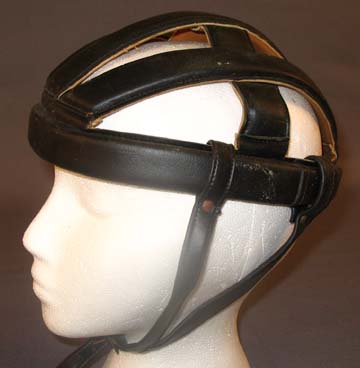Bicycle helmets were invented in the 1970s. They were initially made from hard shell materials for better protection.
Bicycle helmets have become essential for rider safety. In the 1970s, concerns over head injuries led to their invention. Early models used hard shell materials and foam liners. This combination provided effective protection against impacts. Over time, helmet designs have evolved.
Modern helmets are lighter, more aerodynamic, and comfortable. They also meet strict safety standards. Wearing a helmet significantly reduces the risk of serious head injuries. This makes them crucial for cyclists of all ages. Investing in a good helmet is a smart choice for every rider. It ensures safety and peace of mind on the road or trail.

Credit: www.davison.com
Early Bicycle Safety
The invention of bicycle helmets has an interesting history. Early bicycle safety was a major concern. Cyclists faced many risks on the road. Let’s explore the initial efforts to keep cyclists safe.
Initial Concerns
In the 19th century, bicycles became popular. They were a new mode of transport. People worried about safety. Roads were rough and full of hazards. Falls and injuries were common. Many cyclists got hurt. There was no protective gear at that time. Safety became a pressing issue.
First Safety Measures
Early safety measures were basic. Cyclists wore hats and caps. These offered little protection. Some used padded headgear. This was better but still not enough. The need for helmets grew stronger.
- Simple hats and caps
- Padded headgear
- Growing need for helmets
Then, a breakthrough came. The first bicycle helmets were invented in the 1970s. They were made from hard plastic. These helmets had foam padding inside. This offered better protection. Cyclists started to wear them. Safety improved significantly.
Modern helmets are even better. They are lightweight and strong. They have advanced materials. Safety standards ensure their quality. Today, helmets are a must for all cyclists.
Origins Of Bicycle Helmets
Bicycle helmets have a fascinating history. Early cyclists faced many dangers. Thus, the need for head protection became apparent. Over time, helmets evolved to improve safety and comfort.
First Designs
The first bicycle helmets were simple. They used leather and padded strips. These helmets offered minimal protection. Cyclists wore them more for comfort than safety.
Early designs looked like leather caps. They had little impact resistance. Still, they marked the beginning of helmet development.
Pioneering Manufacturers
Several companies led the charge in helmet innovation. Bell Sports was one such pioneer. They introduced the first polystyrene helmet in the 1970s. This design provided better protection.
Other manufacturers like Giro and Specialized followed. They introduced advanced materials and designs. These innovations made helmets lighter and safer.
Below is a table of key pioneering manufacturers and their contributions:
| Manufacturer | Contribution | Year |
|---|---|---|
| Bell Sports | First Polystyrene Helmet | 1970s |
| Giro | Advanced Aerodynamic Designs | 1980s |
| Specialized | Lightweight Materials | 1990s |
These manufacturers set the stage for modern helmet safety standards. Their innovations continue to protect cyclists today.
Evolution In Materials
The evolution of materials in bicycle helmets has significantly improved safety. Early helmets were simple and offered limited protection. Over time, advancements in materials have enhanced their effectiveness and comfort.
Leather To Plastics
The first bicycle helmets were made from leather. These leather helmets, known as “hairnets,” were common in the early 20th century. They provided minimal protection and were mainly used by professional cyclists. In the 1970s, the introduction of plastic helmets marked a significant improvement. These helmets used a hard plastic shell with foam padding inside. They offered better impact protection than leather helmets.
Impact Of Technology
Technological advancements have played a crucial role in helmet materials. The introduction of expanded polystyrene (EPS) foam in the 1980s was a game-changer. EPS foam is lightweight yet absorbs impact effectively. Modern helmets also use polycarbonate shells for added durability. These materials have made helmets safer and more comfortable to wear.
| Material | Era | Characteristics |
|---|---|---|
| Leather | Early 20th Century | Minimal protection, used by professionals |
| Plastic | 1970s | Hard shell, foam padding, better impact protection |
| EPS Foam | 1980s | Lightweight, absorbs impact effectively |
| Polycarbonate | Modern | Durable, enhances safety |
The use of advanced materials has led to innovations like MIPS technology. MIPS stands for Multi-directional Impact Protection System. It reduces rotational forces during an impact. This technology has made helmets even more effective in preventing head injuries.
In summary, the evolution in materials has transformed bicycle helmets. From leather to advanced plastics, each innovation has improved safety and comfort.
Helmet Legislation
Helmet legislation has played a crucial role in promoting bicycle safety. Laws requiring helmet use have saved countless lives. Over the years, different regions have adopted various helmet laws to protect cyclists.
Initial Laws
The first bicycle helmet laws appeared in the late 20th century. California introduced the first mandatory helmet law for children in 1987. This law required children under 18 to wear helmets while riding bikes. Other states soon followed, each with their own regulations.
These early laws targeted children to reduce head injuries. Studies showed that helmets significantly reduce the risk of serious head injuries. Legislators saw the need to protect young cyclists first.
Global Adoption
Bicycle helmet legislation quickly spread worldwide. Countries like Australia and New Zealand adopted helmet laws in the 1990s. Australia was the first country to implement a nationwide helmet law in 1990. New Zealand followed with a similar law in 1994.
Europe also saw countries adopting helmet laws, though not uniformly. Spain, for instance, made helmets mandatory for children in 2004. Finland requires all cyclists to wear helmets, but enforcement is lenient.
Helmet legislation varies by region, reflecting local attitudes towards cycling and safety. Some countries have comprehensive helmet laws, while others focus on education and voluntary use.
The table below highlights key dates in global helmet legislation:
| Country | Year | Details |
|---|---|---|
| USA (California) | 1987 | First state to mandate helmets for children |
| Australia | 1990 | First country with a nationwide helmet law |
| New Zealand | 1994 | Mandatory helmet law for all cyclists |
| Spain | 2004 | Mandatory for children under 16 |
| Finland | 2003 | Mandatory for all, but not strictly enforced |
Helmet legislation continues to evolve as new research emerges. Governments aim to balance safety with promoting cycling as a healthy activity.
Innovations In Design
Bicycle helmets have come a long way since their invention. Modern helmets are the result of years of innovation. These innovations focus on making helmets safer and more comfortable.
Aerodynamic Shapes
Aerodynamic shapes are a key advancement in helmet design. Early helmets were bulky and heavy. Today, designers focus on reducing air resistance. This helps cyclists ride faster and with less effort. Aerodynamic helmets have smooth, sleek surfaces. This design cuts through the air more efficiently.
Table of Aerodynamic Benefits:
| Feature | Benefit |
|---|---|
| Smooth Surface | Less Air Resistance |
| Sleek Shape | Higher Speeds |
| Lightweight | Easy to Wear |
Improved Ventilation
Improved ventilation has also transformed helmet design. Early helmets lacked proper ventilation. This made them uncomfortable in hot weather. Modern helmets have multiple vents. These vents allow air to flow through the helmet. They help keep the rider cool and comfortable.
Benefits of Improved Ventilation:
- Better airflow
- Cooler head
- Reduced sweat
- Enhanced comfort
These innovations in design have made bicycle helmets more efficient. Cyclists today enjoy better performance and comfort.

Credit: www.davison.com
Cultural Shifts
The invention of bicycle helmets marked a significant change in cycling culture. Initially, helmets faced resistance. Over time, cultural shifts have led to greater acceptance and use of helmets.
Public Perception
Initially, many cyclists viewed helmets as unnecessary. Some even thought they were uncomfortable and unattractive. Public perception began to change with awareness of head injuries. Studies showed helmets reduced serious head injuries by up to 85%. As a result, people began to see helmets as essential for safety.
Governments and organizations started campaigns promoting helmet use. Schools and communities held events to educate about helmet safety. These efforts helped shift public opinion. Now, many see wearing a helmet as a smart and responsible choice.
Influence Of Professional Cyclists
Professional cyclists played a big role in changing helmet culture. Initially, many pros resisted helmets too. But as racing speeds increased, so did the risks. In the 1990s, the Union Cycliste Internationale (UCI) began requiring helmets in professional races.
This move had a huge impact. Fans saw their cycling heroes wearing helmets. This helped normalize helmet use among amateur cyclists. Seeing professionals prioritize safety encouraged everyday riders to do the same. The influence of professional cyclists was vital in promoting helmet use globally.
Modern Safety Standards
Modern bicycle helmets are essential for rider safety. These helmets must meet strict safety standards. The standards ensure maximum protection during accidents. It’s crucial to understand these standards and how they keep us safe.
Certification Processes
Before a bicycle helmet reaches the market, it must undergo rigorous testing. Safety organizations conduct these tests. They check for impact resistance, strap strength, and more.
- Impact Resistance: Helmets must withstand significant force.
- Strap Strength: Straps should not break during impact.
- Field of Vision: Helmets should not obstruct the rider’s view.
Passing these tests earns a certification mark. This mark assures the helmet meets safety standards. Look for this mark when buying a helmet.
Global Standards
Different countries have different safety standards for bicycle helmets. Here’s a table showing some major standards:
| Country | Standard |
|---|---|
| United States | CPSC |
| Europe | EN 1078 |
| Australia | AS/NZS 2063 |
Each standard has unique requirements. For instance, CPSC in the US focuses on impact tests. The EN 1078 standard in Europe includes retention system tests.
Understanding these standards helps you choose a safe helmet. Always check for the relevant certification when purchasing a helmet.
Future Of Bicycle Helmets
The future of bicycle helmets holds exciting advancements. As technology evolves, helmets become smarter and more eco-friendly. Let’s explore the latest trends shaping the future of bicycle helmets.
Smart Helmets
Smart helmets are revolutionizing safety for cyclists. These helmets come equipped with advanced features:
- Built-in Sensors: Detects impacts and alerts emergency contacts.
- GPS Tracking: Helps find your location if you get lost.
- Bluetooth Connectivity: Allows hands-free calls and music streaming.
- Integrated Lights: Enhances visibility during night rides.
| Feature | Benefit |
|---|---|
| Built-in Sensors | Improves safety by detecting impacts. |
| GPS Tracking | Locates your position accurately. |
| Bluetooth Connectivity | Enables hands-free communication. |
| Integrated Lights | Increases visibility at night. |
Sustainability Trends
Sustainability is becoming a priority in helmet manufacturing. Companies are focusing on eco-friendly materials and processes:
- Recycled Materials: Using recycled plastics and foams reduces waste.
- Biodegradable Options: Helmets made from biodegradable materials lessen environmental impact.
- Energy-efficient Production: Factories are using renewable energy sources.
These trends are not just good for the planet. They also lead to innovative and durable products for cyclists.

Credit: www.helmets.org
Frequently Asked Questions
When Were Bicycle Helmets First Invented?
Bicycle helmets were first invented in the 1970s. They were initially made from hardened foam and were not very popular.
Who Invented The First Bicycle Helmet?
The first modern bicycle helmet was invented by Bell Sports. They introduced it to the market in 1975.
Why Were Bicycle Helmets Invented?
Bicycle helmets were invented to improve rider safety. They help protect the head during accidents and reduce the risk of injury.
What Materials Were Used In Early Helmets?
Early bicycle helmets were made from hardened foam. This foam offered basic protection but lacked the advanced materials used today.
Conclusion
Bicycle helmets have come a long way since their invention. They are now essential for rider safety. Innovations continue to improve protection and comfort. Always wear a helmet to stay safe on the road. Embrace the advancements and enjoy safer cycling experiences.
